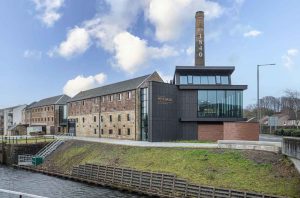Falkirk has always been proud of its skyline – at one end of the town, which lies between Glasgow and Edinburgh, sit The Kelpies, a pair of massive 300-tonne sculptures of mythical Scottish water horses unveiled in 2013, while at the other stands the Falkirk Wheel, the world’s only rotating boat lift, opened in 2002 to link the Union and Forth & Clyde canals.
Between the two protrudes a pair of much older monuments: the famous 43-metre Georgian steeple on the town’s high street, once home to the jail, and the equally-loved red brick chimney at the old Rosebank distillery, nestled on the canal bank. Local people, known affectionately as ‘Bairns’, long feared that the chimney would be demolished following the distillery’s closure, robbing the town of one of its most distinctive landmarks.
Now, the chimney – and the new distillery that surrounds it – are in safe hands. Today (7 June), the new Rosebank distillery will welcome visitors for the first time. Having gone silent for 30 years, the distillery that was once known as ‘The King of the Lowlands’, is ready to reclaim its throne, thanks to a new team and new stills, but the same spirit character.
Auspicious beginnings
Rosebank traces its roots back to 1840, when James Rankine – a local wine merchant and tea blender – turned the former maltings for the nearby Camelon distillery into a distillery in its own right. It eventually became part of United Distillers & Vintners (UDV), one of the forerunners of the present-day Diageo, Scotland’s largest distiller and maker of Johnnie Walker, Bell’s and J&B.
The oil crises in the 1970s triggered high inflation and a drop in global demand for Scotch, leading to a ‘whisky loch’ of overproduction in the 1980s. Rosebank was one of the final casualties, closing its doors in 1993, with the site sold to the British Waterways Board – now Scottish Canals – in 2002.
A project by Arran Brewery to revive the site by turning it into a brewery, bottling hall, and micro-distillery was abandoned in 2014. Instead, the old distillery was bought in 2017 by the Russell family, owners of Ian Macleod Distillers (IMD) , the company behind the Glengoyne and Tamdhu distilleries. IMD also purchased the ‘Rosebank’ brand name and pre-1993 casks from Diageo.
DWWA results out 19 June!
Be the first to know: Subscribe to the DWWA newsletter
The road to revival at Rosebank
Credit: Chris McCluskie Photography
On Tuesday night, the Russell family welcomed scores of guests to the official opening of the new Rosebank distillery, designed by Michael Laird Architects, and built using tonnes of reclaimed bricks and timbers from the original derelict distillery buildings. The designers incorporated parts of the original stone walls along the canal side and incorporated the lock-keeper’s cottage, a scheduled monument, Scotland’s highest level of protection for structures of national importance.
The road to reopening rarely runs smoothly. The original copper stills and mash tuns had been stolen during the Christmas and Hogmanay holidays back in 2008-9, while IMD managing director Leonard Russell told the audience on Tuesday that the project had gone ‘three times over budget’. Back in 2017, that budget was reported as between £10m-£12m, with a prospective opening date of ‘2019 at the earliest’.
Yet the results look like they’re worth every penny, with a building that can hold its own against the most modern of Scottish craft distilleries, such as Holyrood, Port of Leith , or Raasay. Tourism has been built into the design from the very start, from a massive audio-visual show projected onto a wall at the beginning of the tour, through to theatrical spotlights picking out individual rows of casks in the small on-site warehouse as the tour guide introduces some of the pre-1993 stock alongside the new ex-bourbon barrels, which began to be filled last summer .
Going back to the future
Credit: Chris McCluskie Photography
At the heart of the new Rosebank sit three stills. While triple distillation is common in Ireland, it’s rare in Scotland, with Auchentoshan in Clydebank near Glasgow fabled as the most famous example. Triple distillation provides more contact with copper, leaving behind a lighter and more floral spirit.
Rosebank’s other distinguishing feature is its set of massive worm tub condensers that sit outside the stillroom. Worm tubs produce a richer and more robust spirit than the alternative shell-and-tube condensers. Rosebank is the only Scottish distillery to combine triple distillation with worm tubs – producing a spirit that’s perhaps best described as an iron fist inside a velvet glove.
To recapture Rosebank’s historic spirit profile, IMD got hold of the original plans and commissioned legendary Speyside coppersmiths Forsyths to recreate the three stolen stills, even down to their oddities. The original wash still, the first of the three used to make spirit, had been inherited from another distillery and had its distinctive swan neck chopped off to fit inside the old still house and replaced with a flat plate, with a lyne arm connected to its neck instead.
‘You’ll notice that they’re f***ing weird shapes,’ laughed Leonard Russell. ‘But [distillery manager] Malcolm [Rennie] has done a fantastic job – he’s making spirit that’s spectacularly fantastic out of those stills.’
Related articles
Legendary Port Ellen distillery reopens
Single malt breaks £2bn barrier despite overall Scotch sales dip
Scotch whiskey industry now contributes £7.1bn to UK economy
The post Rosebank Scotch whisky distillery re-welcomes visitors appeared first on Decanter.
